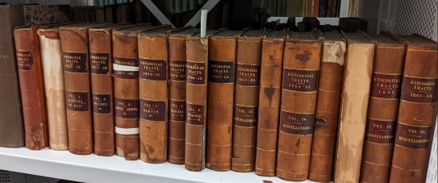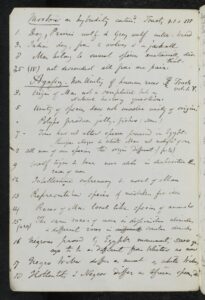
Claire and Harriet proudly display the newly catalogued Lyell’s loose Offprint collection.
Hello, we are interns Claire and Harriet, who have now been working for 5 months on Charles Lyell’s Offprint collection held by Heritage Collections. In our first blog post, we covered how our work on these offprints was starting to reveal the extensive network of researchers and topics that Lyell was collecting and reading about. And we’re now finished!
Within this collection, we have worked through all sorts of sizes and types of Offprints, from larger folios (slightly bigger than A4), the smaller Offprints (roughly A5 size), as well as oversized, some miscellaneous items, as well as offprints of Lyell’s own published works. To date, we have now catalogued 1291 separate offprints and organised them into 32 boxes! Many have needed alphabetical reordering, where they have been previously misplaced or incorrectly labelled. It was especially satisfying to see this final re-shuffling and re-labelling of these boxes, now all under our new catalogued order.
But, we were not quite done! True to every other archive listing project (ever), we still had 22 bound volumes to tackle! Shelved along with other unaccessioned material, and originally part of the Geology Library, these volumes are embossed with the titles ‘Geological Tracts’ a somewhat vague title, that was assumed to point to various other organisations or societies. Some had titles, and numbers embossed on the outside, others were ‘unknown’, their place in the series unrecorded. In fact, these 22 volumes contain annotations by Lyell, and are a unique set, recording his reading.

Lyell’s ‘Geological Tracts’
“Geological tracts Unknown Vol. 2”, “Vol. 5”, and ‘Vol. 7”, feature journal articles and book extracts discussing Charles Darwin’s Origin of Species, while volumes “Geological Tracts Vol. 3 Antiquity of Man”, “Vol. 5”, and “Vol. 11”, feature offprints on flint implements and geology in France. Each volume brings together as many as 33 different authors, all originating from different journals, with their own published volume numbers, page numbers – as well as Lyell’s own handwritten notes.
Papers about the Human species, their origin, their place within nature, and the different phases of human evolution within the geological/archaeological record, appear throughout, for example, Rolleston’s “Distinctive Character of brain of Man and of Anthropomorphic Apes” (Vol 2, 17) and Babbage’s (1859) “Chalk on human implements mixed with bones of extinct animals” (Vol 3, 16).
The bound volumes labelled “Miscellaneous” include assorted articles on geological formations, zoology, submergence, glaciation, plants, and the deep-sea from locations all over including: the Americas, India, Europe, Islands, with a higher proportion on England, Wales, and Scotland.
‘Tracts’ was a word that we had seen before – it had cropped up several times whilst cataloguing the other separate offprints, expressed in handwritten notes on their front covers. From this we have inferred that ‘Tracts’ refer to these bound volumes. We have also become familiar with the authors and contributors and their topics of interest, and recognised they were reappearing in these bound volumes, and that Lyell appears to collate the topics that he was most interested in. It has been incredibly rewarding to see the re-emerging connections, made possible from our work over the previous months, making more sense in these final bound volume offprints.
Finally, we have applied our deep understanding of Lyell’s Offprints, to his ‘Index Notebooks’.
 At the end of the series of Lyell’s Notebooks, there is a set of 16 index notebooks – but that title isn’t as clear as it seems. Our work has explored the relationship between these indexes, and Lyell’s reading, and it appears 13 of these notebooks are the key to unlocking the bound ‘Geological Tracts’. There are 2 General Indexes which relate to a series of 11 indexes, filled with Lyell’s reading, research, and correspondence notes. The second General Index (currently A5/12) lists alphabetically the names and papers of key researchers Lyell made notes on. This index lists where Lyell’s notes can be found inside both the Tracts and the series of 11 notebooks.
At the end of the series of Lyell’s Notebooks, there is a set of 16 index notebooks – but that title isn’t as clear as it seems. Our work has explored the relationship between these indexes, and Lyell’s reading, and it appears 13 of these notebooks are the key to unlocking the bound ‘Geological Tracts’. There are 2 General Indexes which relate to a series of 11 indexes, filled with Lyell’s reading, research, and correspondence notes. The second General Index (currently A5/12) lists alphabetically the names and papers of key researchers Lyell made notes on. This index lists where Lyell’s notes can be found inside both the Tracts and the series of 11 notebooks.
 Aided by our comprehensive lists, we were able to put our theories as to how these records connect, to the test. For example, Lyell’s notes on Agassiz’s ‘Distribution of Animals’ is listed as Index 1.122 and Tracts 1.6. Therefore, these notes can be found in index book 1 (A5/15), page 122, and the paper itself can be found in Geological Tracts 1 entry 5 (Geological Society Vol. 1. 1850-1855). Because of this, we were able to correctly identify 2 volumes marked ‘unknown’, as ‘Geological Tracts‘ 6 and 12. We can piece together the whole set, and, recreate their original order – including some that are dated earlier, and may be their prototype!
Aided by our comprehensive lists, we were able to put our theories as to how these records connect, to the test. For example, Lyell’s notes on Agassiz’s ‘Distribution of Animals’ is listed as Index 1.122 and Tracts 1.6. Therefore, these notes can be found in index book 1 (A5/15), page 122, and the paper itself can be found in Geological Tracts 1 entry 5 (Geological Society Vol. 1. 1850-1855). Because of this, we were able to correctly identify 2 volumes marked ‘unknown’, as ‘Geological Tracts‘ 6 and 12. We can piece together the whole set, and, recreate their original order – including some that are dated earlier, and may be their prototype!
Harriet and Claire’s internship has been funded by the Friends of the University Library – which is apt, given the relationship between Lyell’s archive, and, the Offprints, that technically form part of the book collections. The task of listing the voluminous Offprints must at times, felt never ending – and yet, the application of their knowledge, has meant we can now properly catalogue a crucial set of archival indexes, not to mention, extending Lyell’s network by several 100 people! Adding the detail of Lyell’s ‘reading’ to his other tools – of observation, collecting specimens, and correspondence- is a crucial part of the story of his contribution to how we understand the world today. Thank you both for your amazing efforts!
